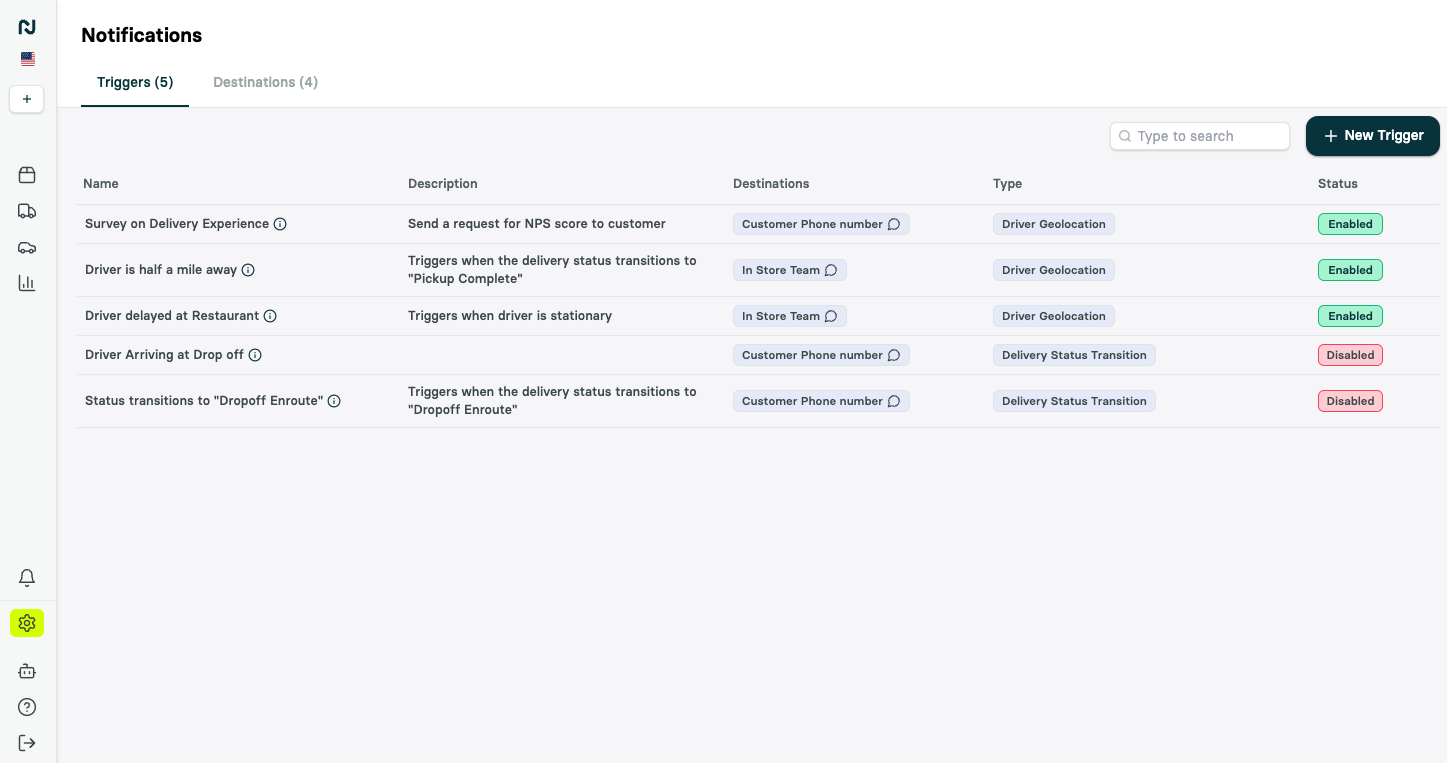
Supported Channels
Nash can send notifications across the following channels:- SMS
- Slack Channel
- Webhook endpoint
Default Notifications
By default, your account will have 3 customer-facing SMS notifications enabled, and 2 internal notifications that are disabled. To see these notifications and edit them if necessary, go to Settings > Triggers in the Nash dashboard.Customer-Facing Notifications
-
Status transitions to “Pickup Complete”
Message:
Your order from {{pickup_business_name}} has been picked up. Stay tuned for more text updates and track the delivery here {{job_tracking_link}} -
Status transitions to “Dropoff Enroute”
Message:
The driver is on their way. They should arrive by {{dropoff_eta}}. -
Status transitions to “Dropoff Complete”
Message:
Your order from {{pickup_business_name}} has been delivered.
Internal Notifications (Disabled by Default)
To activate internal notifications, you need to create a Destination and add it to each notification. You can select to receive notifications via SMS, email, Slack, and/or webhook.-
Delivery Booked
Message:
A new delivery has been scheduled with Nash. Track here: {{job_tracking_link}}. -
Task Reassigned
Message:
Task reassigned on job {{job_id}}. Track here: {{job_tracking_link}}.
Recommendations
Setting Up Flags
Flags allow teams to be proactive during live delivery operations. You can enable flags for any notification in the Nash history dashboard under the “Flagged” view.Recommended Triggers
We strongly recommend setting up and enabling these triggers:- Failed to Auto Dispatch: Alerts when a delivery fails to auto-dispatch.
- Address Validation Failed: Notifies when there’s an issue with the customer’s address.
Trigger Options
Here are examples of triggers you can use to send notifications:| Trigger | Description |
|---|---|
delivery_incident_report | Notifies when a delivery incident is reported |
status_changed_too_quickly | Flags when delivery statuses change more rapidly than expected |
dropoff_delayed | Flags when dropoff ETA is significantly later than the specified dropoff time |
driver_geolocation | Provides updates on driver location |
pickup_delayed | Flags when pickup ETA is significantly later than the specified pickup time |
driver_location_vs_delivery_status | Flags when driver’s location doesn’t match the reported delivery status |
stuck_status | Alerts when a delivery seems to be stuck in a particular status |
task_reassignment | Notifies when a delivery task is reassigned |
delivery_status_transition | Informs about changes in delivery status |
autodispatch_failed | Alerts when automatic dispatching of a delivery fails |
address_validation_failed | Notifies when there’s an issue validating an address |
order_needs_attention | Alerts when an order requires manual intervention |
order_ready_to_fulfill | Notifies when an order is ready for fulfillment |
job_creation_failed | Alerts when there’s an error creating a new job |
delivery_cancellation_failed | Notifies when a delivery cancellation attempt fails |
task_health_status | Provides updates on the real-time status of tasks |
internal_driver_not_assigned | Alerts when an internal driver hasn’t been assigned to a task |
nash_ai_invalid_pod | Notifies when the AI system detects an invalid proof of delivery photo |
Dynamic Text Options
Here are examples of variables your can use in notification messages. We add to them regularly, so feel free to request more.| Variable | Description |
|---|---|
| Customer | |
{{customer.first_name}} | The customer’s first name (in dropoff address) |
{{customer.last_name}} | The customer’s last name (in dropoff address) |
{{customer.phone_number}} | The customer’s phone number |
{{customer.email}} | The customer’s email address |
{{customer_feedback_link}} | The URL for the customer to provide feedback |
| Pickup | |
{{org_name}} | Name of your organization in Nash |
{{pickup_business_name}} | The business name from where the order(s) were picked up |
{{pickup_business.phone_number}} | The phone number associated with pickup location |
{{pickup_location.email}} | The email address associated with the pickup location |
{{pickup_eta}} | The pickup ETA |
{{pickup_datetime}} | The actual pickup datetime localized to the pickup location |
| Dropoff | |
{{dropoff_eta}} | The dropoff ETA |
{{dropoff_datetime}} | The dropoff datetime localized to the dropoff location. |
{{dropoff_business_name}} | The dropoff business name. |
{{dropoff_location.address_first_line}} | The first line of the dropoff address |
{{proof_of_delivery_photo_url}} | The URL link to the photo proof of delivery |
| Job | |
{{job_id}} | The job ID e.g. job_oBDDbYnKFCHAfivtjMoabt |
{{job_cfg_id}} | The job configuration ID e.g. cfg_SuC7dAU8VErdhzx9Wa345k |
{{job_metadata.X}} | Pulls from the key X in job_metadata. X can be any field |
{{job_tracking_link}} | The link to track the job |
{{job_details_url}} | The URL to view job details |
{{job_external_identifier}} | The external ID of a job |
{{job_feedback_url}} | The URL for providing job feedback |
| Delivery Provider | |
{{provider_delivery_id}} | The delivery ID provided by the delivery provider |
{{provider_name}} | The name of the delivery provider |
{{driver.name}} | The name of the driver/courier |
{{driver.phone_number}} | The phone number of the driver/courier |
{{delivery_incident_report_type}} | The type of the delivery incident |
{{delivery_incident_report_message}} | The message contained in the delivery incident |
| Nash | |
{{nash_order_id}} | The Nash order ID |
{{nash_order_portal_url}} | The URL to view the order in the Nash portal |
{{nash_order_validation_errors}} | Any validation errors associated with the Nash order |
{{nash_order_external_id}} | The external ID of the Nash order |
{{nash_order_pickup_location.email}} | The email associated with the pickup location for the Nash order |
{{nash_order_dropoff_location.email}} | The email associated with the dropoff location for the Nash order |
{{nash_order_pickup_business_name}} | The business name of the pickup location for the Nash order |
{{nash_order_dropoff_business_name}} | The business name of the dropoff location for the Nash order |
{{nash_order_pickup_time}} | The pickup time for the Nash order |
{{reference_id}} | The order’s reference ID |
| Misc | |
{{request_id}} | The ID of the request as generated by Nash’s API service. Helpful for debugging purposes. |